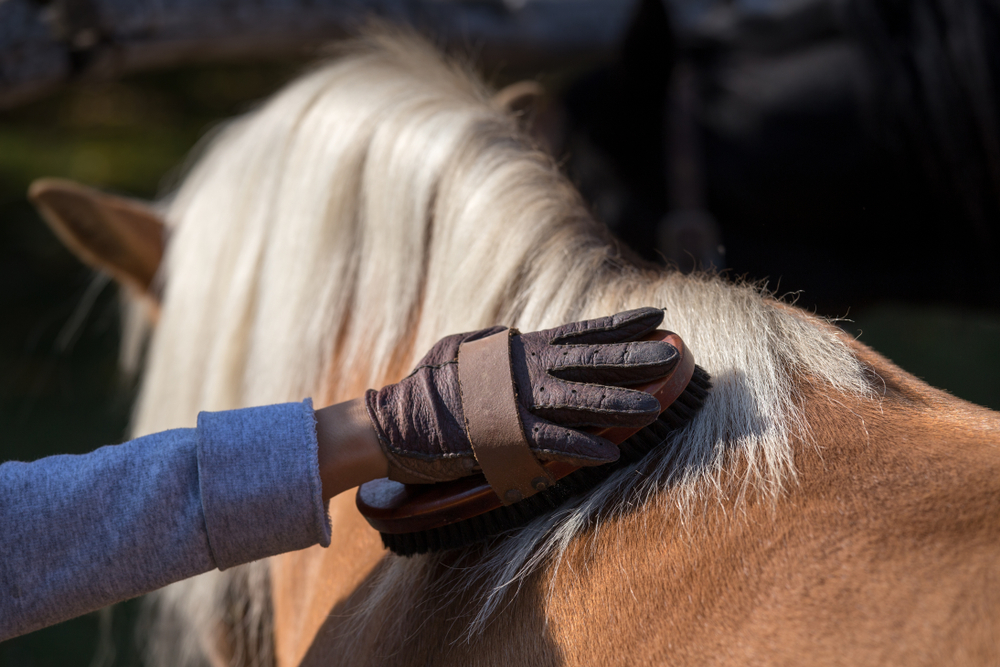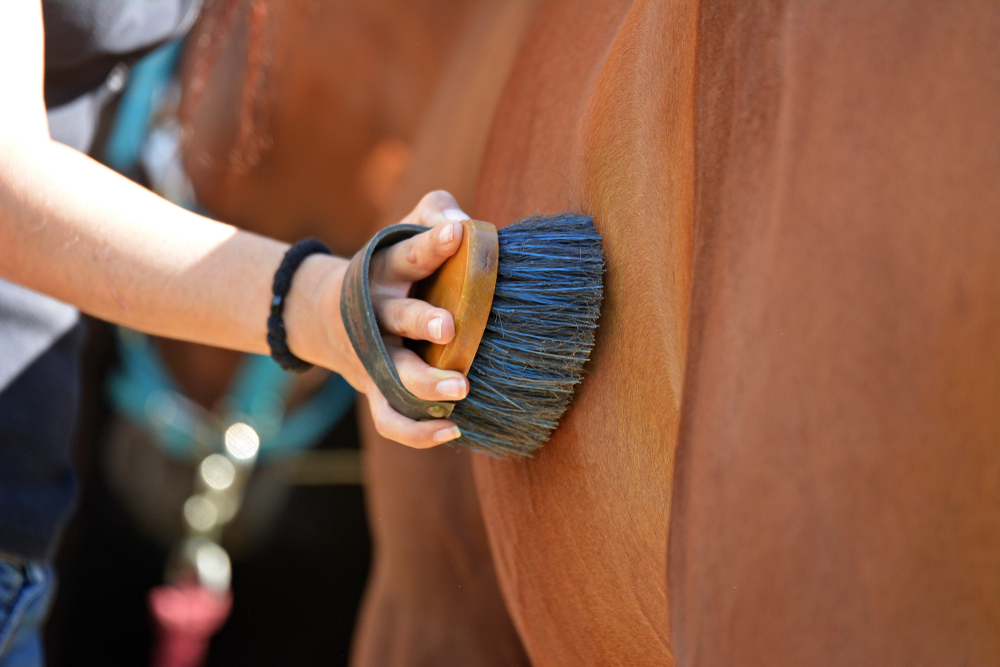- Your source for stall mats, rubber arena footing, arena harrows and arena dust control.

Brushing horses can seem like a lot of hard work for minimal gain. I recently had one student protest that he didn’t need to brush his little Arab after riding because his horse was “mostly clean.” This incident brought home the fact that many of the routine horse care protocols experienced horse owners follow may seem incomprehensible to novice riders and owners.
Brushing your horse before riding is essential to ensure their comfort during the ride. Daily grooming has numerous health benefits for your horse. It improves circulation, maintains coat health, aids in preventing skin conditions, and enables you to notice any changes in your horse’s condition.
Owning and caring for horses is a physically demanding and time-consuming job. One of the chores that often falls to the wayside is routine brushing of horses; however, this short-term time-hack will have long-term consequences. Understanding why your horse needs to be brushed makes it easier to stick to your grooming schedule.
Why Is Regular Grooming Important?
Horses should be groomed every day. Some stable yards hosting competition horses will brush the horses down twice a day as well as before and after each riding session.
Daily grooming is essential for your horse’s physical, mental and social well-being.
To Improve And Maintain Skin and Coat Condition
Daily grooming allows you to remove any thorns, brambles, or burrs that may have become tangled in your horse’s coat, mane, or tail. Blackjacks and other thorny plants may become embedded in the skin, causing a local irritation or small abscess.
Many skin conditions are prevented with regular grooming and the timeous removal of mud and dirt.
Mud Fever
Mud fever, also known as greasy heel, is caused by the bacteria, Dermatophilus congolensi. The condition is characterized by skin irritation, inflammation, and itchiness. Severe cases of mud fever may develop weeping skin lesions around the horses’ heel bulbs, coronet bands, and pasterns.
This bacterium thrives in wet, muddy conditions. Removing the mud daily on high-risk horses is essential to maintain their skin health. Hairy-legged horses with dense feathering are more likely to struggle with mud fever than horses with no feathering. In the case of mud fever, prevention is definitely better than cure!
Primary Seborrhoea
Mud fever is not the only skin condition that can be prevented with daily grooming. Primary seborrhea is a condition affecting the horse’s sebaceous glands and can be dry or oily. This condition results in excessive dandruff and a build-up of waxy plaques.
Daily grooming is essential in the management and prevention of seborrhea flare-ups.
Grooming stimulates the oil glands in the skin, and regular brushing assists with spreading the oils evenly throughout the horse’s coat. Grooming is a non-invasive, inexpensive method for maintaining your horse’s skin condition.
To Monitor Your Horse’s Health
Paying attention while grooming your horse is a simple and effective method of detecting health issues before they become a significant problem.
Daily grooming allows you to learn what’s normal for your horse. Key questions to ask yourself when grooming your horse are:
- What does your horse’s coat and skin feel like when he is healthy?
- How does he usually react to the different types of brushes?
- How do the muscles feel?
- Can you feel his ribs?
Detecting Key Behavioural Changes
Horse’s that start uncharacteristically moving away or posturing when being brushed may be indicating pain in the specific area. For example, horses who experience saddle pain will often threaten to bite when touched along their backs in the saddle region.
Detecting Weight Loss
A fluffy winter coat or busy schedule can often cause owners to miss the signs that their horse is losing weight. Brushing your horse allows you to physically feel (not just see) any changes to your horse’s weight.
Old horses are particularly vulnerable to losing weight in winter and often grow the thickest coat making it hard to spot their weight loss!
To Bond With Your Horse
Horses are social creatures who frequently groom each other as means of bonding. You can leverage your horse’s natural grooming behavior to strengthen his bond with you.
Each horse is different and will enjoy different types of brushes, brush strokes, and pressures. Spend time with your horse experimenting to see what he likes. Eventually, your horse will begin to associate your presence with a soothing massage.
The more time you spend with your horse in a calm, low-stress environment, the more relaxed and confident the two of you will become around each other.
To Remove Loose Hair
Horse’s living in cold climates, old horses, and native UK horse breeds typically grow a coat thick enough to rival a woolly mammoth! During spring, all that winter hair has to come off in preparation for the hot summer months.
Removing the horse’s winter coat is a horrible task. Hair gets everywhere. Down your bra, up your nose, into your eyes, there’s nowhere the hair doesn’t go! It usually feels like you remove enough hair for a second horse.
Routine grooming speeds up the shedding process and turns your woolly mammoth of a horse into a sleek shiny summer unicorn!

Why Should I Brush My Horse Before And After Riding?
Brushing your horse before riding allows you to remove dirt and debris from the saddle and bridle areas. Dried mud, burrs, and dirt will cause pressure sores, bruising, and skin irritation if caught under the saddle or bridle when riding.
Fussy horses can be particularly explosive when expressing their displeasure and discomfort with dirt caught under tack. Many riders report stories about sensitive horses refusing to work if ridden with dirty numnahs!
Brushing your horse after riding allows you to remove dried sweat and improves the blood circulation in tired muscles. After a ride, brushing down your horse is equivalent to a post-exercise massage: it makes him feel good!
Are There Additional Benefits To Brushing Your Horse?
Brushing your horse has additional benefits beyond the obvious:
- Modern life is hectically busy; however, taking the time to groom your horse forces you to slow down and live in the moment. The rhythmic motions of brushing can have a therapeutic, almost meditative quality to them.
- Grooming, particularly during spring when the horses shed their winter coats, is hard work. Vigorously grooming a horse can be quite the upper body workout. My arms always feel like limp spaghetti after an intense groom!
- Lastly, grooming your horse allows you to practice in-hand horsemanship skills. Grooming teaches your horse patience as they learn to stand still for extended grooming sessions. It also allows you to practice moving different parts of the horse’s body around, e.g., hindquarters over, back up, shoulders over, etc.
Conclusion
Brushing your horse is an essential low-cost method of monitoring and maintaining your horse’s health. Routine brushing is critical not only for your horse’s skin and coat condition but also for building your relationship with your horse.
Many new horse owners think that grooming is a waste of time, but this is not true. Grooming is the ultimate time-hack; it allows you to care for your horse’s physical needs while getting in a fitness workout, a therapy session, and a mini-training session for your horse!


